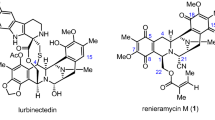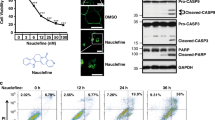Abstract
The daphnane diterpene orthoesters constitute a structurally fascinating family of natural products that exhibit a remarkable range of potent biological activities. Although partial activity information is available for some natural daphnanes, little information exists for non-natural congeners or on how changes in structure affect mode of action, function, potency or selectivity. A gateway strategy designed to provide general synthetic access to natural and non-natural daphnanes is described and utilized in the synthesis of two novel members of this class. In this study, a commercially available tartrate derivative was elaborated through a key late-stage diversification intermediate into B-ring yuanhuapin analogues to initiate exploration of the structure–function relationships of this class. Protein kinase C was identified as a cellular target for these agents, and their activity against human lung and leukaemia cell lines was evaluated. The natural product and a novel non-natural analogue exhibited significant potency, but the epimeric epoxide was essentially inactive.
This is a preview of subscription content, access via your institution
Access options
Subscribe to this journal
Receive 12 print issues and online access
$259.00 per year
only $21.58 per issue
Buy this article
- Purchase on Springer Link
- Instant access to full article PDF
Prices may be subject to local taxes which are calculated during checkout



Similar content being viewed by others
References
Liao, S-G., Chen, H-D. & Yue, J. M. Plant orthoesters. Chem. Rev. 109, 1092–1140 (2009).
Miyamae, Y., Villareal, M. O., Abdrabbah, M. B., Isoda, H. & Shigemori, H. Hirseins A and B, daphnane diterpenoids from Thymelaea hirsuta that inhibit melanogenesis in B16 melanoma cells. J. Nat. Prod. 72, 938–941 (2009).
Chen, H-D., He, X-F., Ai, J., Geng, M-Y. & Yue, J-M. Trigochilides A and B, two highly modified daphnane-type diterpenoids from Trigonostemon chinensis. Org. Lett. 11, 4080–4083 (2009).
Hayes, P. Y., Chow, S., Somerville, M. J., De Voss, J. J. & Fletcher, M. T. Pimelotides A and B, diterpenoid ketal–lactone orthoesters with an unprecedented skeleton from Pimelea elongata. J. Nat. Prod. 72, 2081–2083 (2009).
Hong, J-Y., Nam, J-W., Seo, E-K. & Lee, S. K. Daphnane diterpene esters with anti-proliferative activities against human lung cancer cells from Daphne genkwa. Chem. Pharm. Bull. 58, 234–237 (2010).
Zhang, L. et al. Highly functionalized daphnane diterpenoids from Trigonostemon thyrsoideum. Org. Lett. 12, 152–155 (2010).
Chen, H-D. et al. Trigochinins A–C: three new daphnane-type diterpenes from Trigonostemon chinensis. Org. Lett. 12, 1168–1171 (2010).
Chen, H-D. et al. Trigochinins D–I: six new daphnane-type diterpenoids from Trigonostemon chinensis. Tetrahedron 66, 5065–5070 (2010).
Lin, B-D. et al. Trigoxyphins A–G: diterpenes from Trigonostemon xyphophylloides. J. Nat. Prod. 73, 1301–1305 (2010).
Li, L. Z., Gao, P. Y., Peng, Y., Wang, L. H. & Song, S. J. A novel daphnane-type diterpene from the flower bud of Daphne genkwa. Chem. Nat. Compd 46, 380–382 (2010).
Li, L-Z. et al. Daphnane-type diterpenoids from the flower buds of Daphne genkwa. Helv. Chim. Acta 93, 1172–1179 (2010).
Appendino, G. & Szallasi, A. Euphorbium: modern research on its active principle, resiniferatoxin, revives an ancient medicine. Life Sci. 60, 681–696 (1997).
Mourtzoukou, E. G., Iavazzo, C. & Falagas, M. F. Resiniferatoxin in the treatment of interstitial cystitis: a systematic review. Int. Urogynecol. J. 19, 1571–1576 (2008).
MacDonald, R., Monga, M., Fink, H. A. & Wilt, T. J. Neurotoxin treatments for urinary incontinence in subjects with spinal cord injury or multiple sclerosis: a systematic review of effectiveness and adverse effects. J. Spinal Cord Med. 31, 157–165 (2008).
Wong, G. Y. & Gavva, N. R. Therapeutic potential of vanilloid receptor TRPV1 agonists and antagonists as analgesics: recent advances and setbacks. Brain Res. Rev. 60, 267–277 (2009).
Wender, P. A. et al. The first synthesis of a daphnane diterpene: the enantiocontrolled total synthesis of (+)-resiniferatoxin. J. Am. Chem. Soc. 119, 12976–12977 (1997).
Wender, P. A., Verma, V. A., Paxton, T. J. & Pillow, T. H. Function-oriented synthesis, step economy, and drug design. Acc. Chem. Res. 41, 40–49 (2008).
Wender, P. A. & Miller, B. L. Synthesis at the molecular frontier. Nature 460, 197–201 (2009).
Hu, B-H., Huai, S., He, Z-W. & Wu, X-C. Studies on the constituent of the yuanhua's flower buds. Acta Chim. Sinica 44, 843–845 (1986).
Zhan, Z-J., Fan, C-Q., Ding, J. & Yue, J-M. Novel diterpenoids with potent inhibitory activity against endothelium cell HMEC and cytotoxic activities from a well-known TCM plant Daphne genkwa. Bioorg. Med. Chem. 13, 645–655 (2005).
Jørgensen, N., Iversen, E. H., Paulsen, A. L. & Madsen, R. Efficient synthesis of enantiopure conduritols by ring-closing metathesis. J. Org. Chem. 66, 4630–4634 (2001).
Houk, K. N. et al. Stereoselective nitrile oxide cycloadditions to chiral allyl ethers and alcohols. The ‘inside alkoxy’ effect. J. Am. Chem. Soc. 106, 3880–3882 (1984).
Wender, P. A. & McDonald, F. E. Studies on tumor promoters. 9. A second-generation synthesis of phorbol. J. Am. Chem. Soc. 112, 4956–4958 (1990).
Wender, P. A. & Mascareñas, J. L. Studies on tumor promoters. 11. A new [5 + 2] cycloaddition method and its application to the synthesis of BC ring precursors of phoboids. J. Org. Chem. 56, 6267–6269 (1991).
Domingo, L. R. & Zaragozá, R. J. Toward an understanding of the mechanisms of the intramolecular [5 + 2] cycloaddition reaction of γ-pyrones bearing tethered alkenes. A theoretical study. J. Org. Chem. 65, 5480–5486 (2000).
Zaragozá, R. J., Aurell, M. J. & Domingo, L. R. The role of the transfer group in the intramolecular [5 + 2] cycloadditions of substituted β-hydroxy-γ-pyrones: a DFT analysis. J. Phys. Org. Chem. 18, 610–615 (2005).
Singh, V., Krishna, U. M., Vikrant, V. & Trivedi, G. K. Cycloaddition of oxidopyrylium species in organic synthesis. Tetrahedron 64, 3405–3428 (2008).
Wender, P. A. et al. Studies on oxidopyrylium [5 + 2] cycloadditions: toward a general synthetic route to the C12-hydroxy daphnetoxins. Org. Lett. 8, 5373–5376 (2006).
Trost, B. M. & Rise, F. A reductive cyclization of 1,6- and 1,7-enynes. J. Am. Chem. Soc. 109, 3161–3163 (1987).
Trost, B. M. & Li, Y. A new catalyst of Pd catalyzed Alder ene reaction. A total synthesis of (+)-cassiol. J. Am. Chem. Soc. 118, 6625–6633 (1996).
Jang, H. Y. & Krische, M. J. Rhodium-catalyzed reductive cyclization of 1,6-diynes and 1,6-enynes mediated by hydrogen: catalytic C–C bond formation via capture of hydrogenation intermediates. J. Am. Chem. Soc. 126, 7875–7880 (2004).
Scheidt, K. A. et al. Tris(dimethylamino)sulfonium difluorotrimethylsilicate, a mild reagent for the removal of silicon protecting groups. J. Org. Chem. 63, 6436–6437 (1998).
Nicolaou, K. C., Zhong, Y-L. & Baran, P. S. A new method for the one-step synthesis of α,β-unsaturated carbonyl compounds from saturated alcohols and carbonyl compounds. J. Am. Chem. Soc. 122, 7596–7597 (2000).
Lipshutz, B. H. & Harvey, D. F. Hydrolysis of acetals and ketals using LiBF4 . Synth. Commun. 12, 267–277 (1982).
Zhang, W., Basak, A., Kosugi, Y., Hoshino, Y. & Yamamoto, H. Enantioselective epoxidation of allylic alcohols by a chiral complex of vanadium: an effective controller system and a rational mechanistic model. Angew. Chem. Int. Ed. 44, 4389–4391 (2005).
Schmidt, R. & Hecker, E. Autoxidation of phorbol esters under normal storage conditions. Cancer Res. 35, 1375–1377 (1975).
Zhang, S. et al. Preparation of yuanhuacine and relative daphne diterpene esters from Daphne genkwa and structure–activity relationship of potent inhibitory activity against DNA topoisomerase I. Bioorg. Med. Chem. 14, 3888–3895 (2006).
Griner, E. M. & Kazanietz, M. G. Protein kinase C and other diacylglycerol effectors in cancer. Nat. Rev. Cancer 7, 281–294 (2007).
Alkon, D. L., Sun, M-K. & Nelson, T. J. PKC signaling deficits: a mechanistic hypothesis for the origins of Alzheimer's disease. Trends Pharmacol. Sci. 28, 51–60 (2007).
Richman, D. D. et al. The challenge of finding a cure for HIV infection. Science 323, 1304–1307 (2009).
Wender, P. A., Kee, J-M. & Warrington, J. M. Practical synthesis of prostratin, DPP, and their analogs, adjuvant leads against latent HIV. Science 320, 649–652 (2008).
Toullec, D. et al. The bisindolylmaleimide GF 109203X is a potent and selective inhibitor of protein kinase C. J. Biol. Chem. 266, 15771–15781 (1991).
Zhang, G., Kazanietz, M. G., Blumberg, P. M. & Hurley, J. H. Crystal structure of the Cys2 activator-binding domain of protein kinase Cδ in complex with phorbol ester. Cell 81, 917–924 (1995).
Wender, P. A., Koehler, K. F., Sharkey, N. A., Dell'Aquila, M. L. & Blumberg, P. M. Analysis of the phorbol ester pharmacophore on protein kinase C as a guide to the rational design of new classes of analogs. Proc. Natl Acad. Sci. USA 83, 4214–4218 (1986).
Acknowledgements
This research was supported by the National Institutes of Health (CA31841). Additional funding was provided by the Alexander von Humboldt Foundation (N.B.), Stanford Graduate Fellowships from the Office of the Vice Provost for Graduate Education (N.B.C.) and the Office of Technology Licensing (K.E.L.), Bristol-Myers Squibb Graduate Fellowship in Organic Chemistry (J.A.K.), Amgen Graduate Fellowship (C.K.) and Eli Lilly Graduate Research Fellowships (N.B.C., J.A.K., J.M.K.). J-M. Yue is thanked for supplying a sample of yuanhuapin for biological evaluation. P.L. Boudreault performed epoxidation studies on phorbol-12,13-dibutyrate. L. Cegelski is acknowledged for providing access to tissue culture space and equipment. K. Cimprich contributed A549 and K562 cells. X-ray crystallography was performed at the University of California, Berkeley, and analysed by X. Ottenwaelder or collected and analysed by A. Oliver.
Author information
Authors and Affiliations
Contributions
P.A.W., N.B., N.B.C., L.R.J., C.K., J.M.K., J.A.K. and K.E.L. conceived and designed the experiments. N.B., N.B.C., L.R.J., C.K., J.M.K., J.A.K. and K.E.L. performed the experiments and analysed the data. P.A.W., N.B.C. and K.E.L. co-wrote the paper. All authors commented on the manuscript.
Corresponding author
Ethics declarations
Competing interests
The authors declare no competing financial interests.
Supplementary information
Supplementary information
Supplementary information (PDF 4898 kb)
Supplementary information
Crystallographic data for compound 19a (CIF 25 kb)
Supplementary information
Crystallographic data for compound 20 (CIF 46 kb)
Supplementary information
Crystallographic data for compound 16a (CIF 25 kb)
Supplementary information
Crystallographic data for compound 6a (CIF 26 kb)
Rights and permissions
About this article
Cite this article
Wender, P., Buschmann, N., Cardin, N. et al. Gateway synthesis of daphnane congeners and their protein kinase C affinities and cell-growth activities. Nature Chem 3, 615–619 (2011). https://doi.org/10.1038/nchem.1074
Received:
Accepted:
Published:
Issue Date:
DOI: https://doi.org/10.1038/nchem.1074
This article is cited by
-
Tigliane and daphnane diterpenoids from Thymelaeaceae family: chemistry, biological activity, and potential in drug discovery
Journal of Natural Medicines (2023)
-
Practical synthesis of the therapeutic leads tigilanol tiglate and its analogues
Nature Chemistry (2022)
-
Total synthesis of the Daphniphyllum alkaloid daphenylline
Nature Chemistry (2013)
-
Function first
Nature Chemistry (2011)



